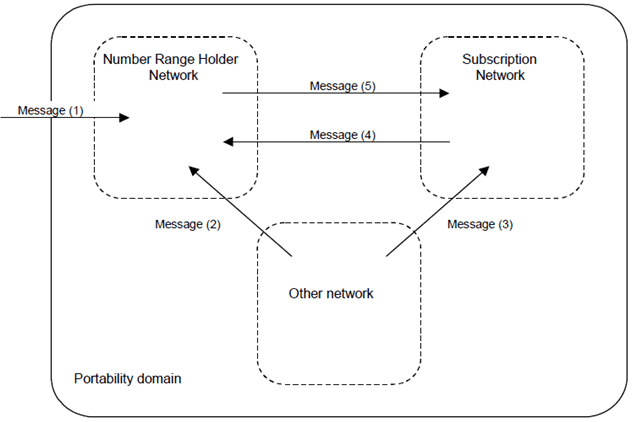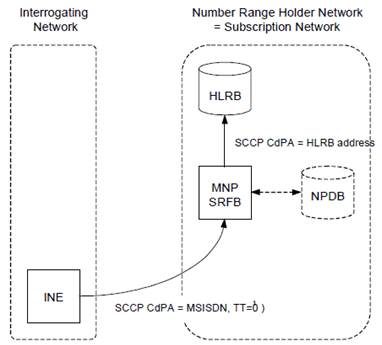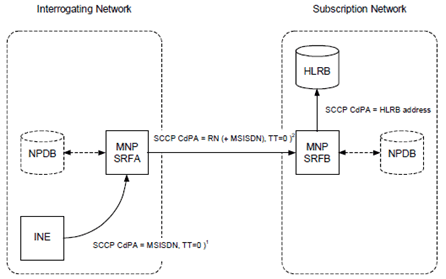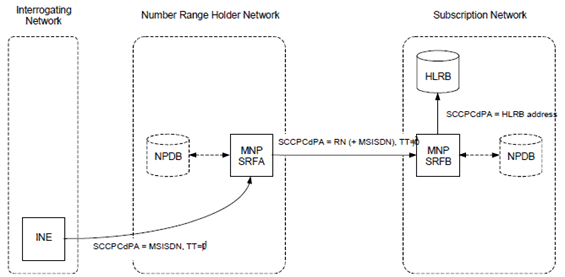Content for TS 23.066 Word version: 18.0.0
B Handling of Non-Call Related Signalling
B.1 Handling of Non-call Related Signalling
B.1.1 Routeing Conventions
B.1.2 Network Architecture
B.2 Signalling Scenarios
B.2.1 Non-call Related Signalling Message for a Non-ported Number - Indirect Routeing
B.2.2 Non-call Related Signalling Message for a Ported or Non ported Number - Direct Routeing
B.2.3 Non-call Related Signalling Message for a Ported Number Indirect Routeing
...
...
B (Normative) Handling of Non-Call Related Signalling p. 42
B.1 Handling of Non-call Related Signalling p. 42
B.1.1 Routeing Conventions p. 42
Figure B.1.1 illustrates the routeing of non-call related signalling messages between networks in a number portability environment.

Figure B.1.1: Routeing of non-call related signalling messages in a number portability environment
(⇒ copy of original 3GPP image)
(⇒ copy of original 3GPP image)
If a non-call related signalling message is originated outside the portability domain, this message (1) is received by the number range holder network. The number range holder network routes the message (5) onward to the subscription network.
If a non-call related signalling message is originated in a network inside the portability domain and this network supports direct routeing, this message (3) is routed to the subscription network.
If a non-call related signalling message is originated in a network inside the portability domain and this network does not support direct routeing, the message (2, 4) is routed to the number range holder network. The number range holder network routes the message (5) onward to the subscription network. This is referred to as indirect routeing.
B.1.2 Network Architecture p. 42
In a PLMN that supports MNP, non-call related signalling messages as mentioned in clause B.1.1 are relayed by an MNP-Signalling Relay Function (MNP-SRF). The MNP-SRF provides re-routeing capability for signalling messages addressed using the MSISDN. The MNP-SRF obtains routeing information from the NP database to identify the subscription network associated with a particular national MSISDN. The interface between the MNP-SRF and the NP database is considered implementation dependent and is not detailed further. For further details see clause 4.3.
From the perspective of the PLMN in which the MNP-SRF resides, the MSISDN in the CdPA represents either:
- An own number ported out.
- An own number not ported out.
- A foreign number ported in.
- A foreign number ported to a foreign network.
- A foreign number not known to be ported.
B.2 Signalling Scenarios p. 44
B.2.1 Non-call Related Signalling Message for a Non-ported Number - Indirect Routeing p. 44
Figure B.2.1 shows the MNP-SRF operation for routeing a non-call related signalling message for a non-ported number where the interrogating network is inside the portability domain and indirect routeing is used or the interrogating network is outside the portability domain.

Figure B.2.1: MNP-SRF operation for routeing a non-call related signalling message for a non-ported number where the interrogating network is inside the portability domain and indirect routeing is used or the interrogating network is outside the portability domain
(⇒ copy of original 3GPP image)
(⇒ copy of original 3GPP image)
The Interrogating Network Entity (INE) submits a non-call related signalling message. When MNP-SRFB receives the message, MNP-SRF operation is triggered. The MNP-SRF functionality analyses the MSISDN in the CdPA and identifies the MSISDN as being non-ported using information that may be retrieved from an NP database. Figure B.2.1 shows an example where the MNP-SRF function then re-routes the message to HLRB.
B.2.2 Non-call Related Signalling Message for a Ported or Non ported Number - Direct Routeing p. 45
Figure B.2.2 shows the MNP-SRF operation for routeing a non-call related signalling message for a ported or non-ported number where the interrogating network supports direct routeing. If the interrogating network is the subscription network, MNP-SRFA and MNP-SRFB coincide; i.e. the signalling message passes the MNP-SRF only once.

Figure B.2.2: MNP-SRF operation for routeing a non-call related signalling message for a ported or non-ported number where the interrogating network supports direct routeing
(⇒ copy of original 3GPP image)
(⇒ copy of original 3GPP image)
The Interrogating Network Entity (INE) submits a non-call related signalling message. When MNP-SRFA receives the message, MNP-SRF operation is triggered. The MNP-SRF functionality analyses the MSISDN in the CdPA and identifies the subscription network using information that may be retrieved from an NP database. The MNP-SRF function then modifies the CdPA according to the rules agreed for the portability domain and routes the message to MNP-SRFB in the subscription network.
When MNP-SRFB receives the message, MNP-SRF operation is triggered. The MNP-SRF functionality analyses the MSISDN in the CdPA and identifies the MSISDN as being ported into the network using information that may be retrieved from an NP database. Figure B.2.2 shows an example where the MNP-SRF function then re-routes the message to HLRB.
B.2.3 Non-call Related Signalling Message for a Ported Number Indirect Routeing p. 46
Figure B.2.3 shows the MNP-SRF operation for indirectly routeing (i.e. via the number range holder network) a non-call related signalling message for a ported subscriber.

Figure B.2.3: MNP-SRF operation for indirectly routeing (i.e. via the number range holder network) a non-call related signalling message for a ported subscriber
(⇒ copy of original 3GPP image)
(⇒ copy of original 3GPP image)
The Interrogating Network Entity (INE) submits a non-call related signalling message. This message is routed on MSISDN global title to MNP-SRFA in the number range holder network.
When MNP-SRFA receives the message, MNP-SRF operation is triggered. The MNP-SRF functionality analyses the MSISDN in the CdPA and identifies the subscription network using information that may be retrieved from an NP database. The MNP-SRF function then modifies the CdPA according to the rules agreed for the portability domain and routes the message to MNP-SRFB in the subscription network.
When MNP-SRFB receives the message, MNP-SRF operation is triggered. The MNP-SRF functionality analyses the MSISDN in the CdPA and identifies the MSISDN as being ported into the network using information that may be retrieved from an NP database. Figure B.2.3 shows an example where the MNP-SRF function then re-routes the message to HLRB.